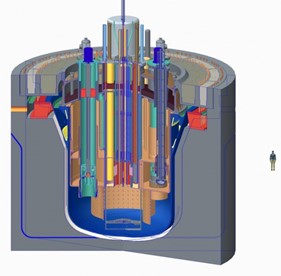Probleemstelling:
SCK-CEN is developing a research reactor as prototype for the 4th generation of nuclear reactors. It was named MYRRHA (Multi-purpose hYbrid Research Reactor for High-tech Applications) and it has several advantages, such as increased safety and reduced nuclear waste through transmutation. The reactor is scheduled to be commissioned in 2036.

Figure 1: Cross-section of the MYRRHA reactor.
MYRRHA will use Lead-Bismuth Eutectic (LBE) as primary coolant. This coolant has a very high density (about 10 times heavier than water), which leads to advantages and limitations. On the one hand, natural circulation can be more easily established, which is positive for passive safety. On the other hand, the flow has more inertia, inducing larger forces on the components. For long and thin-walled components like the primary heat exchangers, flow-induced vibration can limit the service life.
An engineering estimation of the expected frequencies and amplitudes is needed to confirm the integrity of the heat exchangers. Empirical correlations, based on data from air and water flows, cannot be used due to the much larger added mass of the fluid to be considered in the oscillation analysis.